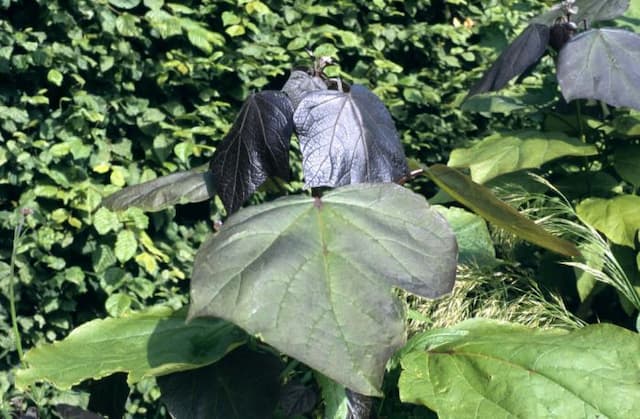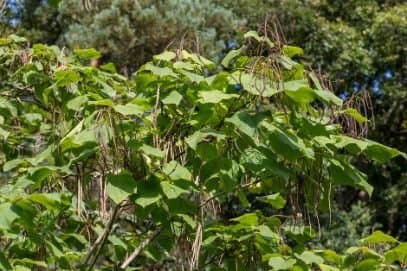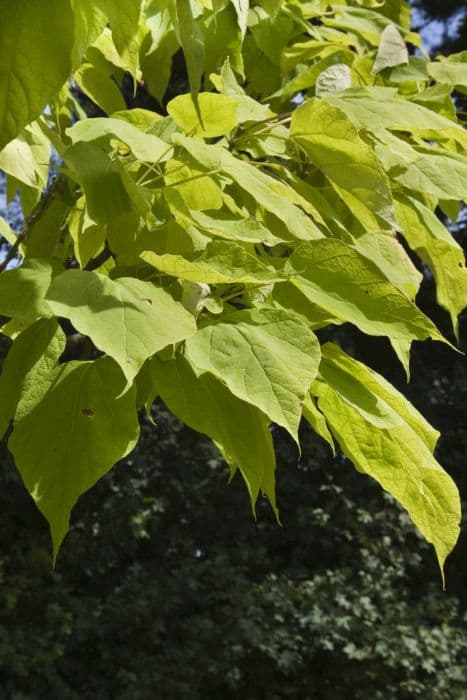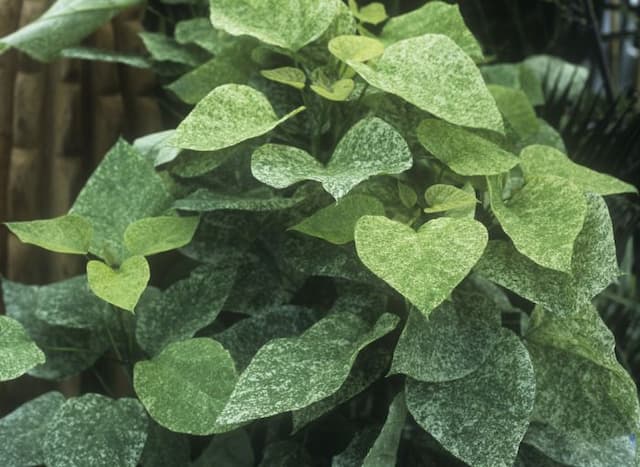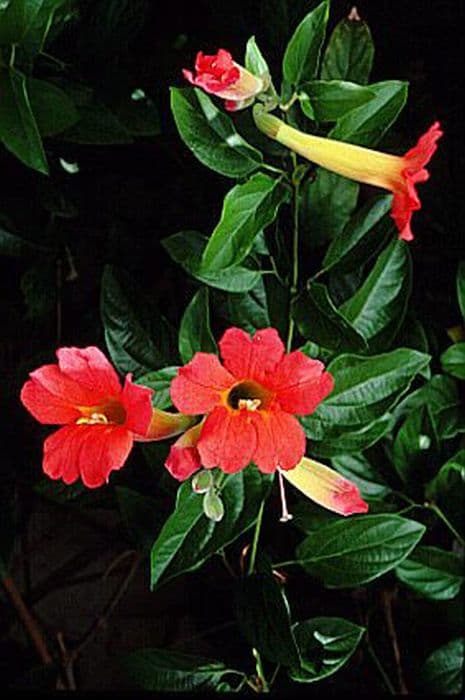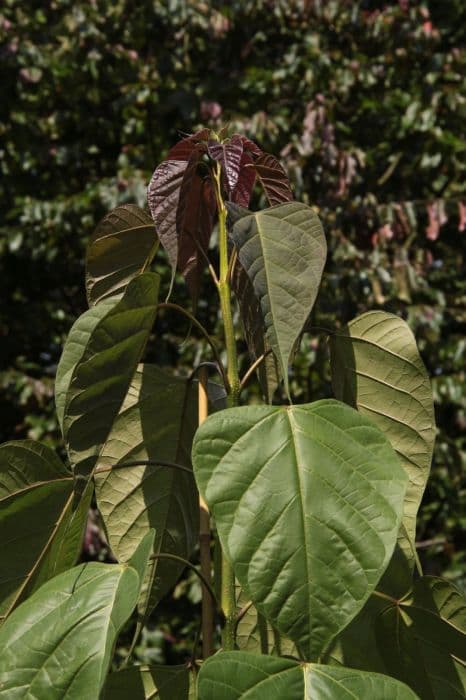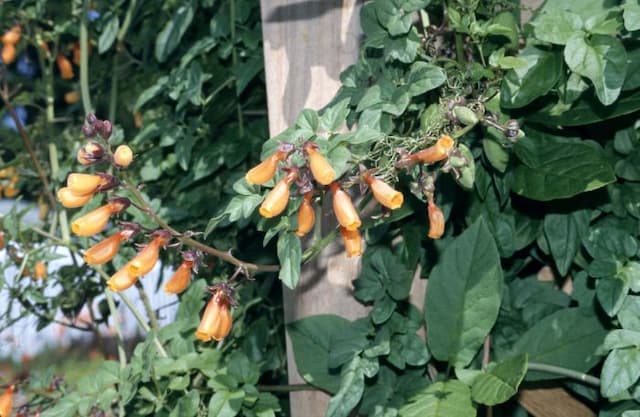Dwarf Catalpa Catalpa bignonioides 'Nana'
ABOUT
The Catalpa bignonioides 'Nana', commonly known as the Dwarf Catalpa, is a unique ornamental plant with a visually striking appearance. It is characterized by a dense, rounded canopy that gives it a neat and compact shape. The leaves of this plant are quite large, heart-shaped, and a bright, lush green color, which can turn yellow in the autumn season. When in bloom, it sports showy clusters of white flowers that are marked with yellow and purple spots, resembling small trumpets or orchids. These flowers typically appear in the late spring or early summer and are known for their distinct and captivating look. Following the flowering period, the Dwarf Catalpa produces long, slender, bean-like pods which hang elegantly from its branches, adding further interest to the plant's profile. The bark of the Dwarf Catalpa is relatively thick and textured, providing a sturdy look to its trunk and branches, which tend to spread wide to form its distinctive canopy shape. With its bold foliage and attractive flowers, this plant is often used for its aesthetic appeal in various landscaping designs.
About this plant
 Names
NamesFamily
Bignoniaceae.
Synonyms
Southern Catalpa, Cigar Tree, Indian Bean Tree, Fish-bait Tree, Dwarf Catalpa.
Common names
Catalpa bignonioides 'Nana'.
 Toxicity
ToxicityTo humans
The Southern catalpa is generally considered to have a low toxicity level to humans. While not commonly eaten, parts of the plant, if ingested, could potentially cause mild stomach upset due to the presence of certain compounds such as iridoid glycosides. However, there is limited information on severe poisoning cases from this plant in humans. Care should still be taken to avoid ingesting parts of the Southern catalpa, especially by children or pets, as individual reactions can vary.
To pets
For pets, the Southern catalpa can also be considered to have low toxicity. If ingested by pets, such as dogs or cats, it may cause mild gastrointestinal upset, which could include symptoms like vomiting or diarrhea. Nonetheless, the plant does not typically induce severe poisoning in pets. Owners should still discourage pets from chewing on or eating parts of the Southern catalpa, as individual sensitivities can lead to varying reactions.
 Characteristics
CharacteristicsLife cycle
Perennials
Foliage type
Deciduous
Color of leaves
Green
Height
6-8 feet (1.8-2.4 meters)
Spread
6-8 feet (1.8-2.4 meters)
Plant type
Tree
Hardiness zones
5
Native area
Southeastern United States
Benefits
 General Benefits
General Benefits- Compact Size: The 'Nana' variety of the Southern Catalpa is a dwarf form, making it suitable for smaller gardens and spaces.
- Ornamental Foliage: It has large, heart-shaped leaves that provide a lush, tropical appearance.
- Shade Provision: Its dense canopy offers a cool, shaded area during hot summer months.
- Low Maintenance: Requires minimal pruning and care once established.
- Drought Tolerance: It is relatively tolerant of drought, reducing the need for frequent watering.
- Attracts Wildlife: The flowers can attract bees, butterflies, and other pollinators, while the seeds are food for various bird species.
- Windbreak: Can be used as a windbreak due to its robust structure.
- Erosion Control: The root system helps to stabilize soil and prevent erosion.
- Adaptable: Can thrive in a variety of soil types, including clay, loam, and sandy soils.
- Urban Tolerant: The Southern Catalpa is capable of withstanding urban pollution, making it suitable for city planting.
 Medical Properties
Medical PropertiesThis plant is not used for medical purposes.
 Air-purifying Qualities
Air-purifying QualitiesThis plant is not specifically known for air purifying qualities.
 Other Uses
Other Uses- Compact Privacy Screen: Due to its dense foliage, the 'Nana' variety of Catalpa can be shaped into a small, compact hedge, providing privacy in urban gardens or small spaces.
- Habitat for Wildlife: The large leaves and overall structure of the Dwarf Catalpa can be used to create a microhabitat for beneficial insects and birds in a garden setting.
- Ornamental Topiary: With careful pruning, Dwarf Catalpa can be sculpted into an ornamental topiary that adds a unique and artistic element to landscapes.
- Photography Backdrop: The attractive shape and leaves of the Dwarf Catalpa can be used as a natural green backdrop for outdoor photography.
- Educational Resource: Dwarf Catalpa trees can be used as a tool for teaching about dendrology, botany, and environmental science due to its interesting characteristics.
- Shade for Smaller Aquatic Features: When planted near a small pond or water feature, the Dwarf Catalpa can provide shade, which helps to regulate the water temperature and provide a better environment for aquatic life.
- Bonsai Specimen: Dwarf Catalpa's naturally small stature makes it a suitable option for bonsai cultivation, providing enthusiasts with a unique tree for their collection.
- Artistic Inspiration: The distinct form and blooming patterns of the Dwarf Catalpa can inspire artists, serving as a subject for paintings, drawings, and other art forms.
- Natural Play Structures: With proper formation and maintenance, Dwarf Catalpa branches can be trained to create natural play structures for children to climb and explore.
- Sound Barrier: When grouped together, Dwarf Catalpa trees can help to buffer noise pollution in residential areas due to the density of the foliage.
Interesting Facts
 Feng Shui
Feng ShuiThe Dwarf Catalpa is not used in Feng Shui practice.
 Zodiac Sign Compitability
Zodiac Sign CompitabilityThe Dwarf Catalpa is not used in astrology practice.
 Plant Symbolism
Plant Symbolism- Creativity: The Catalpa bignonioides 'Nana', commonly known as Dwarf Catalpa, has large heart-shaped leaves and showy flowers. This unique appearance can be associated with imagination and the nurturing of creative ideas.
- Endurance: The Dwarf Catalpa is known for its hardiness and ability to withstand tough conditions. This can symbolize an individual's strength and endurance through challenging times.
- Protection: With its broad canopy, the Dwarf Catalpa provides ample shade, which can symbolize shelter, protection, and safety.
 Water
WaterDwarf Catalpa should be watered thoroughly until the soil becomes moist but not sodden, usually this translates to about one to two gallons every week for young trees, and twice a month for established ones during dry spells. It's essential to adjust the frequency based on rainfall, less during wet seasons and more during dry periods. Over-watering can be harmful, so ensure the soil dries out somewhat between watering sessions. An indication that Dwarf Catalpa needs water is when the top two inches of soil feel dry to the touch.
 Light
LightDwarf Catalpa thrives best in full sunlight conditions, which means it should receive at least six to eight hours of direct sunlight daily. It can also tolerate partial shade, but its growth may not be as robust. The best spot for planting is an open area away from taller trees or buildings that could block substantial sunlight.
 Temperature
TemperatureDwarf Catalpas are adaptable to a wide range of temperatures but grow best when the average temperature is between 60°F and 85°F. They can tolerate a minimum temperature down to around -20°F once fully established. Extreme and prolonged temperatures beyond this range, especially heat above 95°F, can stress the plant.
 Pruning
PruningDwarf Catalpas should be pruned to maintain shape and remove any broken or diseased branches. Pruning is best done in late winter or early spring before new growth starts. This tree doesn't require heavy pruning; just thin out crowded branches and cut back any that are outgrowing the desired shape once a year.
 Cleaning
CleaningAs needed
 Soil
SoilThe Dwarf Catalpa prefers well-draining soil rich in organic matter with a pH range of 5.5 to 7.0. A good soil mix for this plant could include garden soil, compost, and a small amount of coarse sand or perlite to improve drainage. Ensuring the soil is fertile and loamy will promote healthy growth.
 Repotting
RepottingThe Dwarf Catalpa, being a small tree, is not commonly grown in containers and usually does not require repotting. When grown as a bonsai, it may be repotted every couple of years to refresh the soil and manage root growth.
 Humidity & Misting
Humidity & MistingThe Dwarf Catalpa is tolerant of a wide range of humidity conditions and does not require any specific humidity levels to thrive outdoors. It typically adapts well to the ambient humidity of the area where it is planted.
 Suitable locations
Suitable locationsIndoor
Not ideal for indoor growing; requires full light and space.
Outdoor
Plant in full sun, provide ample space, and water deeply.
Hardiness zone
5-9 USDA
 Life cycle
Life cycleCatalpa bignonioides 'Nana', commonly known as Dwarf Catalpa, begins its life as a seed, which upon germination, develops into a seedling with characteristic cordate (heart-shaped) leaves. As it grows, it enters the juvenile phase, establishing a stronger root system and a thickening trunk, while producing more foliage. The mature phase sees the Dwarf Catalpa reaching its full size, which is smaller than the species standard due to its dwarf nature, and it begins to flower, producing panicles of white, trumpet-shaped flowers with yellow and purple markings. After pollination, typically by bees, it produces long, slender seed pods that persist into the winter. The plant is deciduous, meaning it sheds its leaves in the fall, entering a period of dormancy over the winter months. With spring the cycle begins anew, with new leaf and flower bud growth, continuing its perennial life cycle.
 Propogation
PropogationPropogation time
Spring to early summer
The most popular method of propagating the Southern Catalpa or Catalpa bignonioides 'Nana' is through seed collection and sowing. Seeds are best collected when the long, bean-like pods turn brown and crack open, typically in the fall. Once collected, the seeds can be directly sown into a well-draining growing medium or stratified to enhance germination by simulating winter conditions. To stratify, seeds are mixed with moist sand and stored in a refrigerator, at about 40 degrees Fahrenheit (4.4 degrees Celsius), for several weeks before planting. When spring arrives, they can be sown in pots or in a nursery bed, pressing them lightly into the soil surface, as they require light to germinate. Seedlings usually appear within a few weeks and can be potted on or planted out when they are large enough to handle and all risk of frost has passed.
